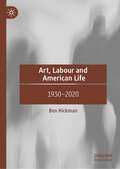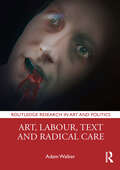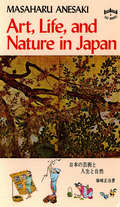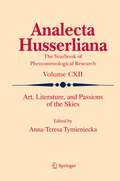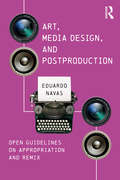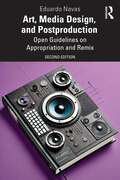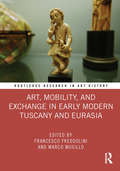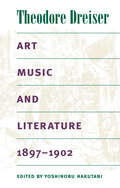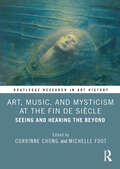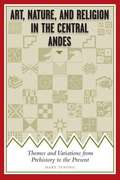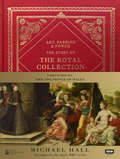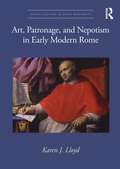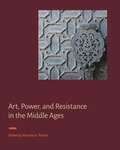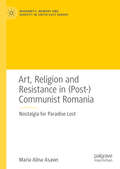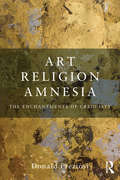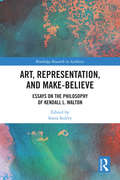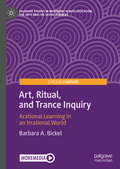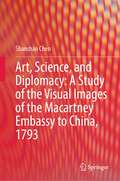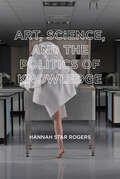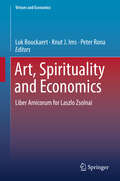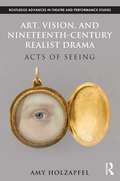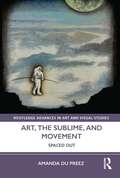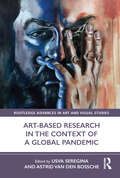- Table View
- List View
Art, Labour and American Life: 1930–2020
by Ben HickmanThis book examines labour in the age of US hegemony through the art that has grappled with it; and, vice versa, developments in American culture as they have been shaped by work’s transformations over the last century. Describing the complex relations between cultural forms and the work practices, Art, Labour and American Life explores everything from Fordism to feminization, from whitecollar ascendency to zero hours precarity, as these things have manifested in painting, performance art, poetry, fiction, philosophy and music. Labour, all but invisible in cultural histories of the period, despite the fact most Americans have spent most of their lives doing it, here receives an urgent re-emphasis, as we witness work’s radical redefinition across the world.
Art, Labour, Text and Radical Care (Routledge Research in Art and Politics)
by Adam WalkerThrough developing an ethical-methodological approach of ‘radical care', this book explores how critical artistic practice might contribute to the materialisation of more equal, more collectively fulfilling, possibilities of being. The chapters trace a set of interweaving lineages perpetuating inequalities: through labour, the body, and onto-epistemology. Art’s all too frequent a-criticality, cooption, or even complicity amidst these lineages is observed, and radical care and the disruptive arttext are developed as twin aspects of an alternative, resistant framework. The book contributes to the critical understanding of inequitable, abstracting processes’ growing determination of increasing parts of our world, and foregrounds art’s position amidst these. It also functions as an interface, both extending the fertile current discourse around care to a contemporary art focus, and at the same time exploring how radical art practices might contribute to a politics rooted in an ethics of care. The book will be of interest to scholars working in art history, studio art, philosophy and politics.
Art, Life, and Nature in Japan
by Masaharu Anesaki Terence BarrowThe artistic and philosophical heritage of Japan has a special meaning for the modern world. During the present century, Japanese thought and Japanese art have exerted a strong influence on the western mind. Art, Life, and Nature in Japan takes us to the roots of Japanese culture and the origins of this influence.In this brief but deeply meaningful book Masaharu Anesaki provides a panoramic view of Japanese culture, with particular emphasis on the spirit of Japanese art. The book has, in fact, established itself as a classic, and it ranks with such other valuable works of its time as The Book of Tea, in which Kakuzo Okakura deals with a similar theme.Anesaki expresses himself in crystal-clear English to convey a message that is significant today as it was before World War II, when his book first appeared. He advocates peace and a turning inward to the beauty of art and nature. He is as familiar with the Zen philosophy of the samurai and the tea master as with sentiments of ancient court noblemen and the quiet thought of a humble peasant.
Art, Literature, and Passions of the Skies: Art, Literature, And Passions Of The Skies (Analecta Husserliana #112)
by Anna Teresa TymienieckaFlashes of lightning, resounding thunder, gloomy fog, brilliant sunshine...these are the life manifestations of the skies. The concrete visceral experiences that living under those skies stir within us are the ground for individual impulses, emotions, sentiments that in their interaction generate their own ever-changing clouds. While our intellect concentrates on the discovery of our cosmic position, on the architecture of the universe, our imagination is informed by the gloomy vapors, the glimmers of fleeting light, and the glory of the skies. Reconnoitering from the soil of human life and striving towards the infinite, the elan of imagination gets caught up in the clouds of the skies. There in that dimness, sensory receptivity, dispositions, emotions, passionate strivings, yearnings, elevations gather and propagate. From the "Passions of the Skies" spring innermost intuitions that nourish literature and the arts.
Art, Media Design, and Postproduction: Open Guidelines on Appropriation and Remix
by Eduardo NavasArt, Media Design, and Postproduction: Open Guidelines on Appropriation and Remix offers a set of open-ended guidelines for art and design studio-based projects. The creative application of appropriation and remix are now common across creative disciplines due to the ongoing recycling and repurposing of content and form. Consequently basic elements which were previously exclusive to postproduction for editing image, sound and text, are now part of daily communication. This in turn pushes art and design to reconsider their creative methodologies. Author Eduardo Navas divides his book into three parts: Media Production, Metaproduction, and Postproduction. The chapters that comprise the three parts each include an introduction, goals for guidelines of a studio-based project, which are complemented with an explanation of relevant history, as well as examples and case studies. Each set of guidelines is open-ended, enabling the reader to repurpose the instructional material according to their own methodologies and choice of medium. Navas also provides historical and theoretical context to encourage critical reflection on the effects of remix in the production of art and design. Art, Media Design, and Postproduction: Open Guidelines on Appropriation and Remix is the first book of guidelines to take into account the historical, theoretical, and practical context of remix as an interdisciplinary act. It is an essential read for those interested in remix studies and appropriation in art, design and media.
Art, Media Design, and Postproduction: Open Guidelines on Appropriation and Remix
by Eduardo NavasA concise guide to the creative application of appropriation and remix that offers a set of open-ended guidelines for art and design studio-based projects, this book explores creativity with emerging technology, including artificial intelligence.This fully revised and expanded second edition engages with the ongoing recycling and repurposing of content and form, and the new directions the emerging form of metacreativity is taking art and design as artists continue to expand their creative methodologies. Exploration of metacreativity is new to this edition, with a focus on remix principles, the implementation of data analysis, and the delegation of parts of the creative process to automated algorithms and artificial intelligence. Each chapter includes an introduction, goals for guidelines of a studio-based project, with an explanation of relevant history, as well as examples and case studies. Each set of guidelines is open-ended, enabling the reader to repurpose the instructional material according to their own methodologies and choice of medium. Navas also provides historical and theoretical context to encourage critical reflection.The second edition remains the first book of guidelines to take into account the historical, theoretical, and practical context of remix as an interdisciplinary act. This is an essential read for those interested in remix studies and appropriation in art, design, and media.
Art, Mobility, and Exchange in Early Modern Tuscany and Eurasia (Routledge Research in Art History)
by Francesco Freddolini Marco MusilloThis book explores how the Medici Grand Dukes pursued ways to expand their political, commercial, and cultural networks beyond Europe, cultivating complex relations with the Ottoman Empire and other Islamicate regions, and looking further east to India, China, and Japan. The chapters in this volume discuss how casting a global, cross-cultural net was part and parcel of the Medicean political vision. Diplomatic gifts, items of commercial exchange, objects looted at war, maritime connections, and political plots were an inherent part of how the Medici projected their state on the global arena. The eleven chapters of this volume demonstrate that the mobility of objects, people, and knowledge that generated the global interactions analyzed here was not unidirectional—rather, it went both to and from Tuscany. In addition, by exploring evidence of objects produced in Tuscany for Asian markets,this book reveals hitherto neglected histories of how Western cultures projected themselves eastwards.
Art, Music, and Literature, 1897-1902
by Theodore DreiserDreiser's captivating portraits of turn-of-the-century America's famous figures In this volume, liberally seasoned with period illustrations, Yoshinobu Hakutani has collected and annotated a rich selection of Theodore Dreiser's pre-fame writings on the cultural milieu of his day. In these brief essays, Dreiser sallies into the vibrant world of creative work in turn-of-the-century America. He inspects the eccentric and revealing paraphernalia of artists' studios, probes the work habits of writers, and goes behind the scenes in the popular song-writing business, where this week's celebrity is next week's has-been. He profiles famous figures and introduces numerous women artists, novelists, and musicians, including the prolific and tireless Amelia Barr (mother of fourteen children and author of thirty-two novels), the illustrator Alice B. Stephens, and the opera singer Lillian Nordica. Hakutani's notes provide biographical detail on dozens of now-obscure individuals mentioned by Dreiser.
Art, Music, and Mysticism at the Fin de Siècle: Seeing and Hearing the Beyond (Routledge Research in Art History)
by Michelle Foot Corrinne ChongThis edited volume explores the dialogue between art and music with that of mystical currents at the turn of the twentieth century. The volume draws on the most current research from both art historians and musicologists to present an interdisciplinary approach to the study of mysticism’s historical importance. The chapters in this edited volume gauge the scope of different interpretations of mysticism and illuminate how an exchange between the sister arts unveil an underlying stream of metaphysical, supernatural, and spiritual ideas over the course of the century. Case studies include Charles Tournemire, Joseph Péladan, Erik Satie, Hilma af Klint, Jean Sibelius, František Kupka, and Wassily Kandinsky. The contributors’ unique theoretical perspectives and disciplinary methodologies offer expert insight on both the rewards and inevitable aesthetic complications that arise when one artform meets another. The book will be of interest to scholars working in art history, musicology, visual culture, and mysticism.
Art, Nature, and Religion in the Central Andes: Themes and Variations from Prehistory to Present
by Mary StrongFrom prehistory to the present, the Indigenous peoples of the Andes have used a visual symbol system—that is, art—to express their sense of the sacred and its immanence in the natural world. Many visual motifs that originated prior to the Incas still appear in Andean art today, despite the onslaught of cultural disruption that native Andeans have endured over several centuries. Indeed, art has always been a unifying power through which Andeans maintain their spirituality, pride, and culture while resisting the oppression of the dominant society. In this book, Mary Strong takes a significantly new approach to Andean art that links prehistoric to contemporary forms through an ethnographic understanding of Indigenous Andean culture. In the first part of the book, she provides a broad historical survey of Andean art that explores how Andean religious concepts have been expressed in art and how artists have responded to cultural encounters and impositions, ranging from invasion and conquest to international labor migration and the internet. In the second part, Strong looks at eight contemporary art types—the scissors dance (danza de tijeras), home altars (retablos), carved gourds (mates), ceramics (ceramica), painted boards (tablas), weavings (textiles), tinware (hojalateria), and Huamanga stone carvings (piedra de Huamanga). She includes prehistoric and historic information about each art form, its religious meaning, the natural environment and sociopolitical processes that help to shape its expression, and how it is constructed or performed by today’s artists, many of whom are quoted in the book.
Art, Passion & Power: The Story of the Royal Collection
by Michael Hall"Hall’s consummate history is not just the story of the evolution of one of the world’s great collections… The book is also a through-the-keyhole insight into the shifting tastes, good or bad, of 1,000 years of monarchs."- The TimesThe Royal Collection is the last great collection formed by the European monarchies to have survived into the twenty-first century. Containing over a million artworks and objects, it covers all aspects of the fine and decorative arts, from paintings by Rembrandt and Michelangelo to grand sculpture, Fabergé eggs and some of the most exquisite furniture ever made. The Royal Collection also offers a revealing insight into the history of the British monarchy from William the Conqueror to Queen Elizabeth II, recording the tastes and obsessions of kings and queens over the past 500 years. With unprecedented access to the royal residences of St James' Palace, Windsor Castle and Buckingham Palace, Art, Passion & Power traces the history of this national institution from the Middle Ages to the present day, exploring how royalty used the arts to strengthen their position as rulers by divine right and celebrating treasures from the Crown Jewels to the "Abraham" tapestries in Hampton Court Palace. Author Michael Hall examines the monarchy's response to changing attitudes to the arts and sciences during the Enlightenment and celebrates the British monarchy's role in the democratisation of art in the modern world. Packed with glimpses of rarely seen artworks, Art, Passion & Power is a visual treat for all art enthusiasts. Accompanying the BBC television series and a major exhibition at the Royal Academy, Art, Passion & Power is the definitive statement on the British monarchy's treasures of the art world.
Art, Patronage, and Nepotism in Early Modern Rome (Visual Culture in Early Modernity)
by Karen J. LloydDrawing on rich archival research and focusing on works by leading artists including Guido Reni and Gian Lorenzo Bernini, Karen J. Lloyd demonstrates that cardinal nephews in seventeenth-century Rome – those nephews who were raised to the cardinalate as princes of the Church – used the arts to cultivate more than splendid social status. Through politically savvy frescos and emotionally evocative displays of paintings, sculptures, and curiosities, cardinal nephews aimed to define nepotism as good Catholic rule. Their commissions took advantage of their unique position close to the pope, embedding the defense of their role into the physical fabric of authority, from the storied vaults of the Vatican Palace to the sensuous garden villas that fused business and pleasure in the Eternal City. This book uncovers how cardinal nephews crafted a seductively potent dialogue on the nature of power, fuelling the development of innovative visual forms that championed themselves as the indispensable heart of papal politics. The book will be of interest to scholars working in art history, early modern studies, religious history, and political history.
Art, Power, and Resistance in the Middle Ages (Signa: Papers of the Index of Medieval Art at Princeton University)
by Pamela A. PattonThis volume addresses a vital point of intersection between images in the Middle Ages and those in the modern world: the potential of medieval works of art to convey messages of power and resistance. Provoked by the misuse of medieval imagery in modern discussions, the contributors to this volume assess how medieval images connect to discourses of power in both the past and the present.The contributors each began with a single question: In the eyes of their makers and viewers, how were medieval images understood to assert or to resist forces of power? Their case studies come from a wide range of cultural, geographic, and historical contexts: the Byzantine, Ottonian, and Valois courts; the Umayyad and Castilian regimes of the Iberian Peninsula; the pluralistic military and commercial zones of the eastern Mediterranean; and the metaphorical as well as personal battlegrounds linked to medieval “courtly love” culture. Over eight chapters, the authors highlight patterns of visual rhetoric still evident in art today. They invite readers to contemplate how modern priorities and sensibilities might amplify, mute, or transform the discourses related to power and resistance that were threaded through the visual culture of the Middle Ages.This insightful book should be of value to anyone interested in medieval art history and art’s relationship to power and authority in society.In addition to the editor, the contributors include Heather A. Badamo, Elena N. Boeck, Thomas E. A. Dale, Martha Easton, Eliza Garrison, Anne D. Hedeman, Tom Nickson, and Avinoam Shalem.
Art, Religion and Resistance in: Nostalgia for Paradise Lost (Modernity, Memory and Identity in South-East Europe)
by Maria Alina AsaveiThis book illuminates the interconnections between politics and religion through the lens of artistic production, exploring how art inspired by religion functioned as a form of resistance, directed against both Romanian national communism (1960-1989) and, latterly, consumerist society and its global market. It investigates the critical, tactical and subversive employments of religious motifs and themes in contemporary art pieces that confront the religious ‘affair’ in post-communist Romania. In doing so, it addresses a key gap in previous scholarship, which has paid little attention to the relationship between religious art and political resistance in communist Central and South-East Europe.
Art, Religion, Amnesia: The Enchantments of Credulity
by Donald PreziosiArt, Religion, Amnesia addresses the relationship between art and religion in contemporary culture, directly challenging contemporary notions of art and religion as distinct social phenomena and explaining how such Western terms represent alternative and even antithetical modes of world-making. In this new book, Professor Preziosi offers a critique of the main thrust of writing in recent years on the subjects of art, religion, and their interconnections, outlining in detail a perspective which redefines the basic terms in which recent debates and discussions have been articulated both in the scholarly and popular literature, and in artistic, political and religious practice. Art, Religion and Amnesia proposes an alternative to the two conventional traditions of writing on the subject which have been devoted on the one hand to the ‘spiritual’ dimensions of artistry, and on the other hand to the (equally spurious) ‘aesthetic’ aspects of religion. The book interrogates the fundamental assumptions fuelling many current controversies over representation, idolatry, blasphemy, and political culture. Drawing on debates from Plato’s proposal to banish representational art from his ideal city-state to the Danish cartoons of Mohamed, Preziosi argues that recent debates have echoed a number of very ancient controversies in political philosophy, theology, and art history over the problem of representation and its functions in individual and social life. This book is a unique re-evaluation of the essential indeterminacy of meaning-making, marking a radically new approach to understanding the inextricability of aesthetics and theology and will be of interest to students and researchers in art history, philosophy and religion and cultural theory.
Art, Representation, and Make-Believe: Essays on the Philosophy of Kendall L. Walton (Routledge Research in Aesthetics)
by Sonia SedivyThis is the first collection of essays focused on the many-faceted work of Kendall L. Walton. Walton has shaped debate about the arts for the last 50 years. He provides a comprehensive framework for understanding arts in terms of the human capacity of make-believe that shows how different arts – visual, photographic, musical, literary, or poetic – can be explained in terms of complex structures of pretense, perception, imagining, empathy, and emotion. His groundbreaking work has been taken beyond aesthetics to address foundational issues concerning linguistic and scientific representations – for example, about the nature of scientific modelling or to explain how much of what we say is quite different from the literal meanings of our words. Contributions from a diverse group of philosophers probe Walton’s detailed proposals and the themes for research they open. The essays provide an overview of important debates that have Walton’s work at their core. This book will be of interest to scholars and graduate students working on aesthetics across the humanities, as well as those interested in the topic of representation and its intersection with perception, language, science, and metaphysics.
Art, Ritual, and Trance Inquiry: Arational Learning in an Irrational World (Palgrave Studies in Movement across Education, the Arts and the Social Sciences)
by Barbara A. BickelThis book provides insights into the practice of trance-based inquiry through arts-based research, serving as a beacon to guide the way to thresholds of ancient, yet novel, transmissions. Embedded in lived experience and theory, this book introduces the reader to the liminal space of place and trance-based inquiry processes entwined with creative artworkings. The interweaving of art, ritual, and trance-based inquiry opens sacred spaces for learning and unlearning that bring spirit into form. Each chapter presents examples from women artists and culminates with experiential practices drawn from the author’s decades of creative peregrinations to assist artists, teachers, and researchers in transmitting a conscious way of practicing and creating with trance.
Art, Science, and Diplomacy: A Study of the Visual Images of the Macartney Embassy to China, 1793
by Shanshan ChenThis book examines how the Embassy members approached, selected, and represented information, and how, in doing so, they helped to shape European perceptions of China. The Macartney Embassy of 1793 was the first British diplomatic mission to China, seeking to open ties between the two empires. As part of the mission, the British government commissioned writers and artists to chronicle the geography and culture of a civilization that had, until then, been shrouded in mystery. A central focus of the book is the artwork itself, which provides a window into the diplomatic, artistic and scientific viewpoints underlying the mission. Drawing on archival research, the study recreates the processes through which the Embassy’s draughtsmen, scientists, and diplomats collaborated to represent the visual images, and how the materials were reworked for publication in London. The finished product demonstrates that the artists offered a distinct viewpoint in the representation of China, sometimes differing from the textual accounts, by blending scientific elements and artistic aesthetics in order to demystify China and make it more knowable to a British audience. It was in the interposition of text and image that the British public formulated an ambivalent perception of China that embraced both admiration and disdain. In addition to the scholars, the book targets general readers who are interested in global art and history, and East–West interactions. It contains important images with detailed visual and historical analysis that enable readers to acquire knowledge on how the British represented China and how that image helped to shape the European perception of China during the British global expansion in the eighteenth and nineteenth centuries, and beyond.
Art, Science, and the Politics of Knowledge
by Hannah Star RogersHow the tools of STS can be used to understand art and science and the practices of these knowledge-making communities.In Art, Science, and the Politics of Knowledge, Hannah Star Rogers suggests that art and science are not as different from each other as we might assume. She shows how the tools of science and technology studies (STS) can be applied to artistic practice, offering new ways of thinking about people and objects that have largely fallen outside the scope of STS research. Arguing that the categories of art and science are labels with specific powers to order social worlds—and that art and science are best understood as networks that produce knowledge—Rogers shows, through a series of cases, the similarities and overlapping practices of these knowledge communities. The cases, which range from nineteenth-century artisans to contemporary bioartists, illustrate how art can provide the basis for a new subdiscipline called art, science, and technology studies (ASTS), offering hybrid tools for investigating art–science collaborations. Rogers&’s subjects include the work of father and son glassblowers, the Blaschkas, whose glass models, produced in the nineteenth century for use in biological classification, are now displayed as works of art; the physics photographs of documentary photographer Berenice Abbott; and a bioart lab that produces work functioning as both artwork and scientific output. Finally, Rogers, an STS scholar and contemporary art–science curator, draws on her own work to consider the concept of curation as a form of critical analysis.
Art, Spirituality and Economics: Liber Amicorum for Laszlo Zsolnai (Virtues and Economics #2)
by Luk Bouckaert Peter Rona Knut J. ImsThis volume celebrates the work of Laszlo Zsolnai, a leading researcher and scholar in the field of the ethical and spiritual aspects of economic life, who has made significant contributions to the connection between ethics, spirituality, aesthetics and economic theory. <P><P>The book offers a selection of essays concerned with the ethical, spiritual and aesthetic context within which economics as a social studies discipline should be situated in order to avoid the sort of dehumanising consequences that theories based on utility maximisation and rational choice necessarily entail. It presents the economic activities of human beings not as some sort of preordained obedience to universal laws that operate independently of other human concerns, but, rather, as a part of the human desire for the Aristotelian good life. It looks at the various considerations –moral, spiritual and aesthetic – that take part in the formation of economic decisions in sharp contrast with theories that purport to explain economic phenomena solely on the basis of utility maximisation.
Art, Vision, and Nineteenth-Century Realist Drama: Acts of Seeing (Routledge Advances in Theatre & Performance Studies)
by Amy HolzapfelRealism in theatre is traditionally defined as a mere seed of modernism, a crude attempt to reproduce an exact copy of reality on stage. Art, Vision & Nineteenth-Century Realist Drama redefines realism as a complex and under-examined form of visual modernism, one that positioned theatre at the crux of the encounter between consciousness and the visible world. Tracing a historical continuum of "acts of seeing" on the realist stage, Holzapfel demonstrates how theatre participated in modernity’s aggressive interrogation of vision’s residence in the human body. New findings by scientists and philosophers—such as Diderot, Goethe, Müller, Helmholtz, and Galton—exposed how the visible world is experienced and framed by the unstable relativism of the physiological body rather than the fixed idealism of the mind. Realist artists across media paradoxically embraced this paradigm shift by focusing on the embodied observer. Drawing from extensive archival research, Holzapfel conducts close readings of iconic dramas and their productions—including Scribe’s The Glass of Water, Zola’s Thérèse Raquin, Ibsen’s A Doll House, Strindberg’s The Father, and Hauptmann’s Before Sunrise—alongside analyses of artwork by major painters and photographers—such as Chardin, Nadar, Millais, Rejlander, and Liebermann. In a radical challenge to existing criticism, Holzapfel argues that realism in theatre was never the attempt to reproduce an exact copy of the seen world but rather the struggle to make visible the act of seeing.
Art, the Sublime, and Movement: Spaced Out (Routledge Advances in Art and Visual Studies)
by Amanda du PreezThis book is a critical interdisciplinary approach to the study of contemporary visual culture and image studies, exploring ideas about space and place and ultimately contributing to the debates about being human in the digital age. The upward and downward pull seem in a constant contest for humanity’s attention. Both forces are powerful in the effects and affects they invoke. When tracing this iconological history, Amanda du Preez starts in the early nineteenth century, moving into the twentieth century and then spanning the whole century up to contemporary twenty-first century screen culture and space travels. Du Preez parses the intersecting pathways between Heaven and Earth, up and down, flying and falling through the concept of being “spaced out”. The idea of being “spaced out” is applied as a metaphor to trace the visual history of sublime encounters that displace Earth, gravity, locality, belonging, home, real life, and embodiment. The book will be of interest to scholars working in art history, visual culture, media and cultural studies, phenomenology, digital culture, mobility studies, and urban studies.
Art, the Sublime, and Movement: Spaced Out (Routledge Advances in Art and Visual Studies)
by Amanda du PreezThis book is a critical interdisciplinary approach to the study of contemporary visual culture and image studies, exploring ideas about space and place and ultimately contributing to the debates about being human in the digital age. The upward and downward pull seem in a constant contest for humanity’s attention. Both forces are powerful in the effects and affects they invoke. When tracing this iconological history, Amanda du Preez starts in the early nineteenth century, moving into the twentieth century and then spanning the whole century up to contemporary twenty-first century screen culture and space travels. Du Preez parses the intersecting pathways between Heaven and Earth, up and down, flying and falling through the concept of being “spaced out”. The idea of being “spaced out” is applied as a metaphor to trace the visual history of sublime encounters that displace Earth, gravity, locality, belonging, home, real life, and embodiment. The book will be of interest to scholars working in art history, visual culture, media and cultural studies, phenomenology, digital culture, mobility studies, and urban studies.
Art-Based Research
by Shaun McniffArt therapy and all of the other creative arts therapies have promoted themselves as ways of expressing what cannot be conveyed in conventional language. Why is it that creative arts therapists fail to apply this line of thinking to research? In this exciting and innovative book, Shaun McNiff, one of the field's pioneering educators and authors, breaks new ground in defining and inspiring art-based research. He illustrates how practitioner-researchers can become involved in art-based inquiries during their educational studies and throughout their careers, and shows how new types of research can be created that resonate with the artistic process. Clearly and cogently expressed, the theoretical arguments are illustrated by numerous case examples, and the final part of the book provides a wealth of ideas and thought provoking questions for research. This challenging book will prove invaluable to creative art therapy educators, students, and clinicians who wish to approach artistic inquiry as a way of conducting research. It will also find a receptive audience within the larger research community where there is a rising commitment to expanding the theory and practice of research. Integrating artistic and scientific procedures in many novel ways, this book offers fresh and productive visions of what research can be.
Art-Based Research in the Context of a Global Pandemic (Routledge Advances in Art and Visual Studies)
by Usva Seregina Van den Bossche, AstridLiving through the Covid-19 global pandemic has changed the way that we experience our lives, the way that we relate to one-another, and the way that we engage with the world. Focusing contextually on the initial lockdowns of the pandemic in 2020, this book proposes that art-based research has a central, illuminative role to play in our understanding of unfolding crises. The changes brought on by the global event may not be readily accessible or expressible through traditional academic research. Art-based research offers the opportunity to explore, document, and reflect on the emerging and often ineffable qualities of transformed lives by drawing on emotional, bodily, and interactive aspects of experience. Such an approach allows for meaning-making that makes room for reflexive, interpersonal, and dialogical engagement. The contributions aim to capture and explore lived experiences of the pandemic, as well as begin a discussion about how meaning-making is changing through and beyond the pandemic. This book further explores how the nature and practice of art-based research in itself has been challenged and transformed. The book will be of interest to scholars working in art education, art psychotherapy, consumer research, visual studies, cultural studies, and sociology.
